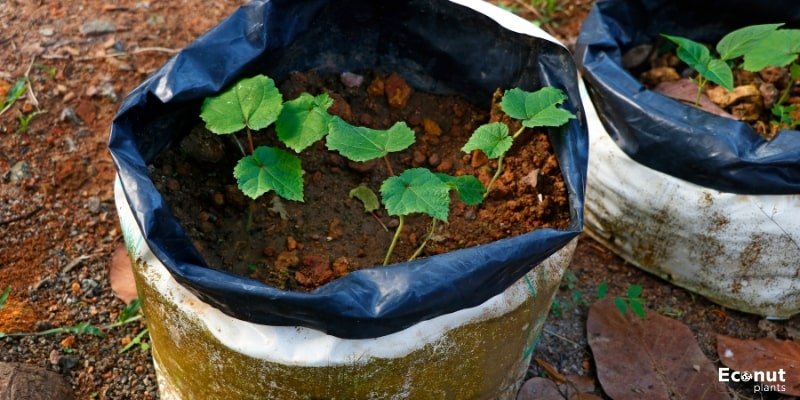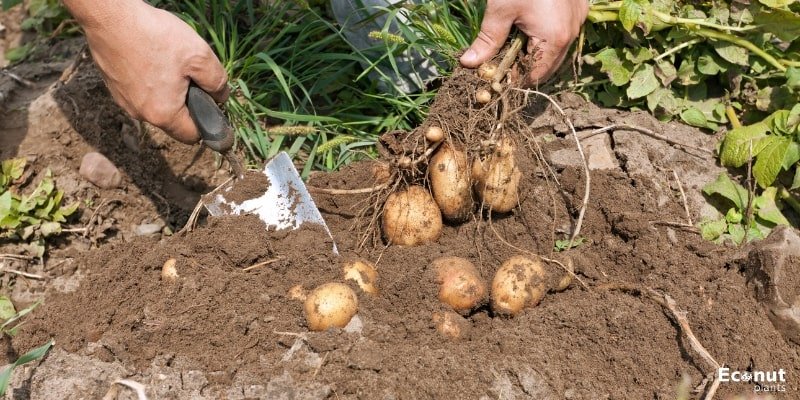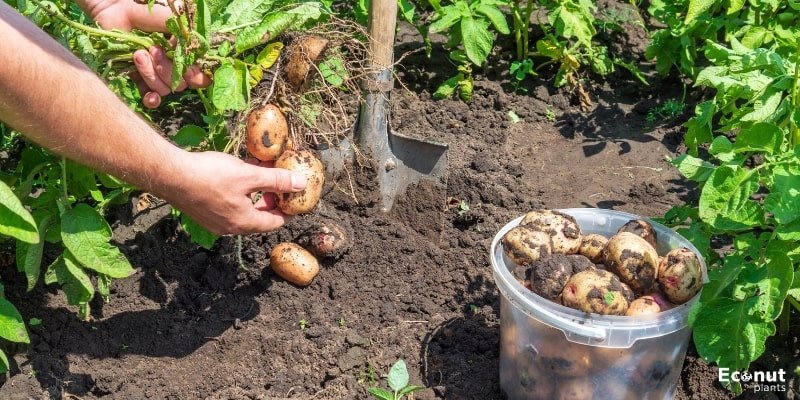Hi there, good day! I’ll be teaching you how to grow potatoes in a paper bag in this tutorial. I developed this method since my yard’s soil is hard, full of clay and rocks, and it doesn’t grow potatoes well.
An internet search suggested growing potatoes in plastic soil bags; however, each time I’ve used this method, the potatoes have either rotted or grown poorly since the plastic holds too much moisture and the plants quickly become root-bound.
Selecting the Right Bag

Materials
Selecting suitable materials will accelerate your progress. Although we have witnessed individuals using plastic trash bags, we do not advocate for this practice. Air circulation won’t be sufficient with plastic bags. Fabric grow bags are our preferred bags for growing potatoes. They have extraordinary strength and breathability.
There are several sizes available for grow bags. You can use a large 50- or 200-gallon bag, or you can use multiple little ones.
Size
You need to give your potatoes enough room to grow into sturdy, healthful plants. Grow bags need to be at least 25 gallons in size to guarantee that tubers develop without being overcrowded.
How big you want to make the changes will depend on how many potato plants you want to grow. If you are looking for a significant harvest, you should use a 50-gallon container or larger.
Drainage Feature
Potatoes require good drainage, particularly when grown in a bag. Water logging should be avoided since it might cause root rot. One advantage of cloth grow bags is that they drain evenly, eliminating the possibility of wet pockets causing your seed potatoes to rot before they sprout. When compared to pots with drainage holes, they drain far more uniformly.
Preparing and Planting Your Potatoes
Potatoes can be grown from seeds, but most typically, tubers are planted. This will result in a perfect duplicate of the original plant. Once there is no chance of frost, potatoes can be grown in the ground.
In most cases, this happens in January or mid-April, depending on your growing zone. They need 90–120 days to grow in the ground, so for optimal results, plant them before summer heat waves begin. Temperatures that are too high prevent young plants from growing.
Preparing Seed Potatoes

If you purchased the potatoes as seed, you may cut them into smaller pieces before planting, around two inches apiece. “Chitting” is the strategy that lets you get more returns on your investment. Additionally, some farmers claim that using this pre-sprouting technique results in increased yields.
If you want to chit your potatoes, you must allow them to dry completely before planting to prevent pests, infections, and decay. Grow towards the sun; roots and shoots will emerge from each eye. Just gather up your already-cut seed potatoes for planting.
Preparing Grow Bags and Planting

You can fill your bags with four to six inches of wet soil mix, plus a tiny bit of compost if you’d like. Tamp down the soil by carefully placing the sack down after picking it up.
Next, using a hand or trowel, drill a hole in each seed potato, placing it slightly below the soil’s surface so that the sprouting eye side is facing upward. Cover the potatoes with two or three more inches of dirt. For a few weeks, give the potatoes water and don’t touch them.
Spacing

When planting in the ground, it is recommended that each potato plant have around 16 inches of space on both sides. When using grows bags, make sure the roots have enough room to spread out and develop into a full-sized tuber. Depending on the kind, one to two potato plants can fit in a 5-gallon bag and four to six plants in a 10-gallon bag.
Location

Potatoes can tolerate a location with absolutely no shadow, but they prefer lots of sunlight, so plant them where they will get at least 6 to 8 hours of sunlight every day. Make water easily accessible.
For potatoes, drip irrigation using tubes will be most effective. You can efficiently set up an irrigation system directly across grow bags when they are arranged in a line.
Also Read: Potato Vine
Potato Care and Observation
Cooler weather is ideal for potatoes to mature and thrive. To enhance performance during hot times, consider covering them with shade fabric if you are in a warmer growing zone.
Weeding

Growing potatoes in bags is an essential step in keeping potato plants healthy and makes weed management much easier. If you allow weeds to take over and deprive your potatoes of essential nutrients, then all you will be doing is feeding and caring for weeds.
Pests

The Colorado potato beetle (CPB) is one of the worst pests that affect potatoes. It’s nearly pesticide-resistant now, and if you leave it unchecked, it will eat away at your entire patch. Scout ahead of time and know what to look for.
Insect netting should be placed over your potato planting bags to protect them until the plants become too tall. To prevent adult beetles from laying eggs on your plants, you could even add tiny hoops to the netting so that it stays in place longer.
Once that happens, you’ll have a serious issue. Similar to other springtime pests, they will simply relocate to a new location to deposit their eggs if they are unable to obtain the food they prefer in your garden.
Fertilizer

Potatoes benefit from a mid-season treatment because they are in the ground for a longer period than other plants. Potting soil provides a general amount of nutrients to get seedlings started. It usually doesn’t harm to add anything with equal parts potassium and phosphorus, even if they don’t require a lot of fertility.
To prevent excessive above-ground green development, you should reduce the amount of nitrogen applied while the tuber is still in the vegetative stage.
A balanced, slow-release granular feed can also be applied approximately four weeks after planting. Expert advice: Adding foliar phosphate to soil fertilizer should boost crop yields.
Hilling Up Potatoes

Planting potatoes in a bag with four to six inches of soil will result in a rather low planting, giving you plenty of area to grow. There is a built-in benefit to planting potatoes in bags.
You can roll down the sides of the bag to ensure that newly emerged plants get adequate sunlight. Buried foliage will produce more potatoes; also, the additional soil will retain moisture longer, deter pests, and lower the bank of weed seeds.
Watering

Just like you would with other crops, give them water as soon as you plant them. Before they become established and start to sprout, they require one to two inches of water every week. Extra water will simply drain out of your bag rather than gather at the bottom if the soil within is well-draining and composted.
This is a vital component of cotton grow bags since too much moisture can cause fungus infections and root damage. It is not out of the ordinary. Generally speaking, I think growers tend to think that overwatering can be more harmful than Underwatering, even if they should know better.
Harvesting
Potato tubers require ninety to one hundred and twenty days to grow and mature properly. Tubers are now full-sized and high in starch. Digging them up is an enormous amount of fun for both kids and adults. Let us explore the best times and methods for harvesting.
When can you harvest potatoes?

When the tubers are ready for harvest, you may tell by looking at the leaves above ground. The plant will inform you that it has exhausted all of its energy to develop the tubers when the leaves start to yellow and die back.
How to Harvest

Harvesting a single plant grown in a grow bag is as simple as taking the entire plant out. As an alternative, you can dig with your hands, use a shovel, or tip the bag over to get rid of any remaining leaf material. To prevent harming the potatoes underneath, exercise caution when using any tools.
New Potatoes

The same types of potatoes you are producing for storage, or full-size potatoes, are also popular choices among gardeners as “new potatoes.” They also benefit from an extended season for harvesting and marketing. Two to three weeks after flowering ceases, new potatoes are ready for harvesting.
Fresh potatoes should not be over-processed, since this could harm their delicate skins, until right before use. Though their shelf life is limited, these make a lovely early-season treat. They taste great with early summer squash baked into a torte or, as an addition, steamed in potato salad.
Storage Potatoes

Potatoes have the longest shelf life when they are kept in some dirt before being stored. Avoid packing potatoes too firmly in a bag or box with vents.
Keep them for a few months in a dry, cold place. Check details particular to your variety to find out how long the likely shelf life is. One to three weeks after the foliage has returned is the ideal time to harvest storage potatoes.
Conclusion
Potatoes can be profitably and successfully cultivated in bags as an alternative to being planted in the ground. If you want to try something new, don’t have your garden beds ready, or just want to eat potatoes that you have produced but are not very experienced in gardening, you might find this to be a suitable replacement.
Throughout the growth season, keep an eye on them, raise the bags to keep animals out, and choose a spot with lots of sunlight.
FAQ
How can I keep mice out of my potato bags?
Raise your grow bags off the ground by a minimum of 12 inches. They would find it challenging to get on tables with metal legs.
Strong odours, such as pepper and mint, are hated by mice. To discourage them, strategically arrange cotton balls soaked in aromatic oils such as peppermint or lavender around your grow bags, or scatter cayenne pepper around them.
Strong herbs like rosemary, basil, garlic, or thyme could also be planted close by. They might also be kept out of the area with hardware cloth fences. Adopt a barn cat to relieve some of the stress if everything else fails!
Are potatoes considered tubers, roots, or tuberous roots?
When planted in the ground, potatoes—which are tubers—can grow in any direction because they have eyes, which set them apart from actual bulbs. All of the plant’s stored starch, or energy, is found in the potato tuber, which is used to produce new potatoes.
How can I tell which stage of growth my potato plants are in?
Potatoes grow a lot underground, out of sight of the grower. To find out more about what goes on beneath those hills all season long, read our piece about the various stages of potato growth.

